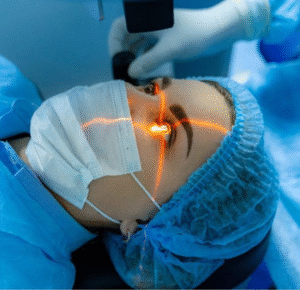
Refractive laser eye surgery has revolutionized the field of ophthalmology, offering millions of people the opportunity to see clearly without glasses or contact lenses. These surgeries correct common vision issues such as nearsightedness (myopia), farsightedness (hyperopia), and astigmatism by reshaping the cornea, the transparent front layer of the eye. With technological advancements, a variety of laser eye surgeries are available, each tailored to specific needs and conditions. Here, we explore the most common types of refractive laser eye surgery, their procedures, benefits, risks, and ideal candidates.1. LASIK (Laser-Assisted In Situ Keratomileusis)Overview
LASIK is the most widely performed laser eye surgery, renowned for its quick recovery time and effectiveness. It corrects myopia, hyperopia, and astigmatism by reshaping the cornea to allow light to focus correctly on the retina.Procedure
The LASIK procedure involves two main steps:
- Creation of a Corneal Flap: A thin flap is created on the cornea’s surface using a microkeratome (a precise cutting instrument) or a femtosecond laser.
- Reshaping with Excimer Laser: The flap is lifted, and an excimer laser reshapes the underlying corneal tissue to correct refractive errors. The flap is then repositioned without the need for stitches.
Benefits
- Quick procedure, typically 10–15 minutes per eye.
- Rapid visual improvement, often noticeable within 24 hours.
- Minimal discomfort during and after surgery.
- High success rate, with most patients achieving 20/20 vision or better.
Risks
- Dry eyes, which may persist for weeks or months.
- Halos or glare, especially at night.
- Potential complications with the corneal flap, though rare.
Ideal Candidates
- Aged 18 and older with a stable prescription for at least one year.
- Healthy corneas with adequate thickness.
- Free from conditions such as keratoconus or severe dry eye syndrome.
2. PRK (Photorefractive Keratectomy)Overview
PRK was the first type of laser eye surgery and remains a popular choice for individuals with thin corneas or those unsuitable for LASIK. Unlike LASIK, PRK does not involve creating a corneal flap.Procedure
- Removal of the Corneal Epithelium: The outer layer of the cornea (epithelium) is removed using an alcohol solution, laser, or surgical instrument.
- Reshaping with Excimer Laser: The laser reshapes the corneal tissue to correct the refractive error.
- Healing: A protective contact lens is placed over the eye to allow the epithelium to regenerate.
Benefits
- Suitable for patients with thin or irregular corneas.
- No risk of flap complications since no flap is created.
- Excellent long-term visual outcomes.
Risks
- Longer recovery time compared to LASIK (up to a few weeks for full vision stabilization).
- Initial discomfort and light sensitivity during the healing process.
- Risk of corneal haze, although advancements have minimized this issue.
Ideal Candidates
- Patients with thin or irregular corneas.
- Those involved in contact sports or professions where eye trauma is a concern.
- Individuals seeking a flap-free procedure.
3. SMILE (Small Incision Lenticule Extraction)Overview
SMILE is a newer, minimally invasive procedure designed specifically for correcting myopia and mild astigmatism. It is gaining popularity for its precision and reduced postoperative dryness.Procedure
- Lenticule Creation: A femtosecond laser creates a small, lens-shaped piece of tissue (lenticule) within the cornea.
- Lenticule Removal: A tiny incision is made, and the lenticule is extracted, altering the cornea’s shape to correct the refractive error.
Benefits
- No corneal flap, reducing the risk of flap-related complications.
- Minimal discomfort during and after the procedure.
- Faster healing and less postoperative dryness compared to LASIK.
Risks
- Limited to correcting myopia and mild astigmatism; not suitable for hyperopia.
- Longer recovery for optimal vision compared to LASIK.
- Rare risk of incomplete lenticule removal.
Ideal Candidates
- Individuals with myopia or mild astigmatism.
- Those seeking a minimally invasive procedure.
- Patients with an active lifestyle or risk of eye trauma.
4. LASEK (Laser-Assisted Sub-Epithelial Keratectomy)Overview
LASEK combines elements of both LASIK and PRK. It is a surface-based procedure like PRK but preserves more of the corneal epithelium.Procedure
- Loosening of the Epithelium: An alcohol solution softens the epithelial layer, which is then moved aside.
- Reshaping with Excimer Laser: The cornea is reshaped to correct vision.
- Repositioning the Epithelium: The epithelial layer is repositioned and protected with a contact lens during healing.
Benefits
- Suitable for patients with thin corneas or high prescriptions.
- Avoids complications related to corneal flap creation.
- Effective for a broad range of refractive errors.
Risks
- Longer recovery period than LASIK, similar to PRK.
- Temporary discomfort, light sensitivity, and blurry vision during healing.
- Risk of epithelial damage during the procedure.
Ideal Candidates
- Patients unsuitable for LASIK due to thin corneas.
- Those seeking a surface-based alternative to LASIK.
5. Epi-LASIKOverview
Epi-LASIK is a variation of LASEK, offering a gentler approach to epithelial removal. It bridges the gap between LASIK and PRK, providing a viable option for patients with specific corneal concerns.Procedure
- Epithelium Separation: A blunt blade (epikeratome) gently separates the epithelial layer without using alcohol.
- Reshaping with Excimer Laser: The cornea is reshaped for optimal vision correction.
- Healing: The epithelium regenerates over time under a protective contact lens.
Benefits
- Less risk of epithelial damage compared to LASEK.
- Suitable for thin or irregular corneas.
- Avoids flap-related complications.
Risks
- Longer healing process compared to LASIK.
- Temporary discomfort and sensitivity during recovery.
Ideal Candidates
- Patients with thin corneas or those prone to epithelial sensitivity.
- Individuals seeking a surface-based procedure with minimal epithelial disruption.
6. Custom Wavefront-Guided LASIKOverview
This advanced version of LASIK uses wavefront technology to create a detailed map of the eye, addressing higher-order aberrations (complex vision issues) that standard LASIK cannot correct.Procedure
- Wavefront Mapping: A wavefront device captures a 3D map of the eye’s imperfections.
- Customized Reshaping: The excimer laser reshapes the cornea based on the unique wavefront map.
Benefits
- Enhanced vision quality, including improved night vision and contrast sensitivity.
- Highly personalized treatment for optimal results.
Risks
- Similar risks as standard LASIK, including dry eyes and potential glare.
- Higher cost due to advanced technology.
Ideal Candidates
- Patients seeking high-definition vision.
- Those with irregular refractive errors or night vision problems.
Choosing the Right Surgery
Selecting the most appropriate refractive laser eye surgery involves a thorough evaluation by an experienced ophthalmologist. Key factors to consider include:
- Refractive Error Type and Severity: Different procedures cater to varying degrees of myopia, hyperopia, and astigmatism.
- Corneal Thickness and Shape: Thin or irregular corneas may rule out LASIK but allow for PRK or SMILE.
- Lifestyle and Occupation: Athletes or individuals at risk of eye trauma may prefer flap-free procedures like PRK or SMILE.
- Recovery Time: Those needing rapid recovery may lean toward LASIK.
Conclusion
Refractive laser eye surgery offers transformative benefits, enabling clear vision and freedom from corrective lenses. Each procedure has its strengths and limitations, and advancements continue to expand treatment options. Whether you opt for LASIK, PRK, SMILE, or another technique, understanding these options ensures you make an informed decision that aligns with your vision goals and lifestyle. Always consult a trusted eye care professional to determine the best path to achieving your visual clarity.


